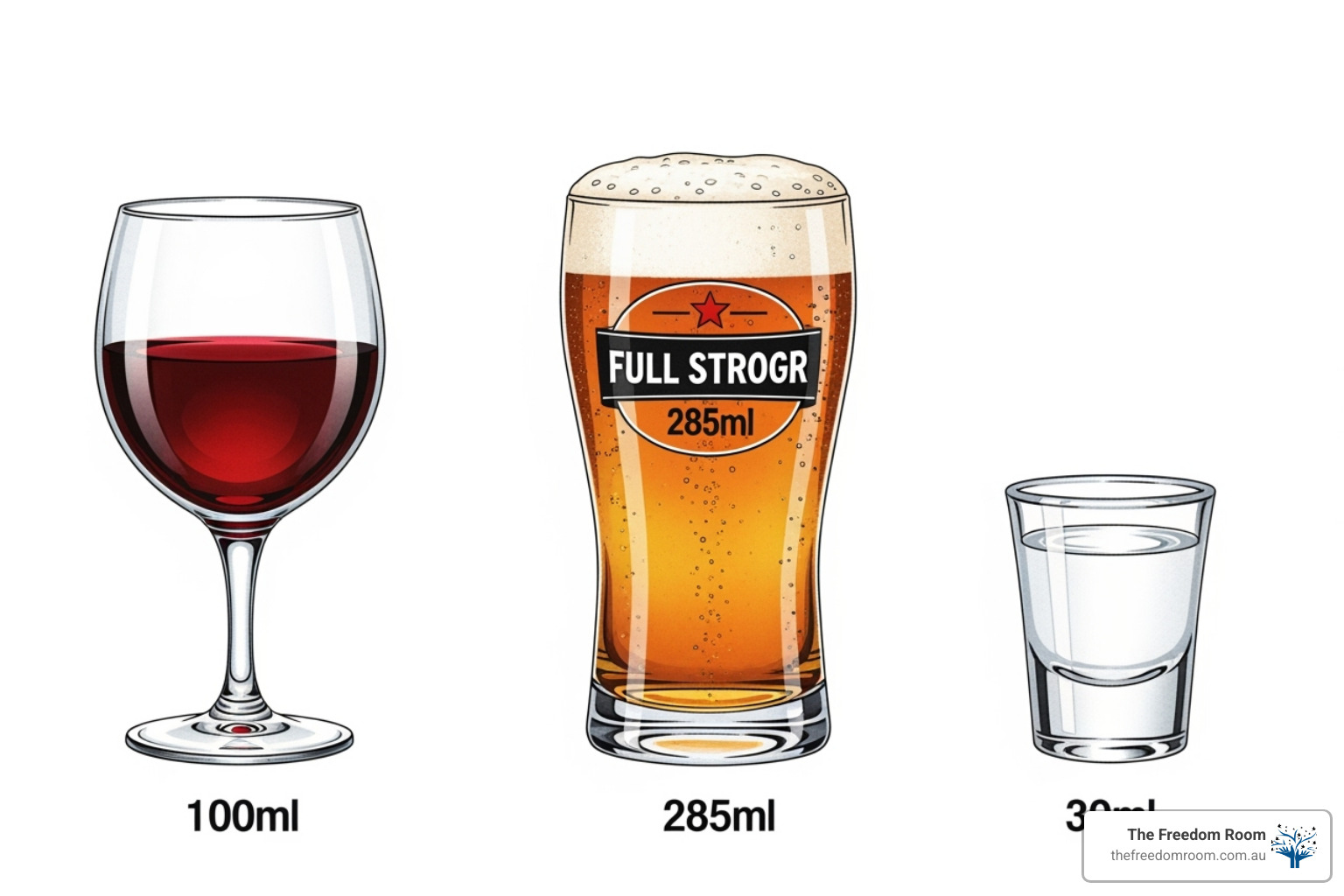Understanding Alcoholism: A Medical Condition with Hope for Recovery
A comprehensive understanding of “what is alcoholism” is the foundational step for individuals concerned about their own or another’s alcohol consumption. Known clinically as Alcohol Use Disorder (AUD), alcoholism is a chronic medical condition characterised by an impaired ability to control alcohol use despite adverse social, occupational, or health consequences.
Quick Answer: What is Alcoholism?
- Medical condition: AUD is a recognised brain disorder, not a moral failing.
- Chronic disease: Similar to diabetes, it requires ongoing management.
- Spectrum condition: It ranges from mild to severe based on symptoms.
- Treatable: Recovery is possible with proper support and treatment.
- Complex causes: It results from a combination of genetic, environmental, and psychological factors.
The Shift to Clinical Terminology
The term “alcoholism” is now less common in medical settings. It has been replaced by Alcohol Use Disorder to reduce stigma and more accurately describe the condition as a spectrum disorder. AUD affects approximately one in twenty Australians, representing a significant public health issue.
The Neurological Basis of AUD
This condition develops as repeated alcohol consumption alters brain chemistry, particularly in regions that regulate reward, stress, and decision-making. These neurobiological changes make it increasingly difficult to control drinking, even when it causes demonstrable harm to an individual’s health, relationships, or employment.
The Potential for Recovery
AUD is a treatable condition. Through evidence-based therapies, professional support, and in some cases medication, individuals can achieve sustained recovery and lead fulfilling, alcohol-free lives. This guide provides an overview of the diagnostic criteria for AUD, its causes, health implications, and the available pathways to recovery.
Understanding Alcohol Use Disorder (AUD): Signs and Diagnosis
Recognising the signs of Alcohol Use Disorder is a critical step toward seeking effective treatment. AUD is a medical condition that impacts brain function, leading to difficulties in controlling alcohol consumption. It is not a moral failing and is responsive to appropriate clinical intervention.
Diagnosis involves a thorough assessment by a healthcare professional. This process includes a clinical interview about drinking patterns, a physical examination to check for related health issues, and screening questionnaires such as the AUDIT (Alcohol Use Disorders Identification Test) to evaluate drinking habits.

Defining Alcoholism: The DSM-5 Criteria
The Diagnostic and Statistical Manual of Mental Disorders, 5th Edition (DSM-5), provides eleven criteria for diagnosing AUD. A diagnosis requires the presence of at least two of these symptoms within a 12-month period. The criteria are organised into four main categories:
- Impaired control: Consuming more alcohol or for a longer period than intended, making unsuccessful attempts to reduce use, spending excessive time on alcohol-related activities, or experiencing strong cravings.
- Social impairment: Neglecting responsibilities at work or home, continuing to drink despite interpersonal problems, or giving up important activities because of alcohol use.
- Risky use: Drinking in hazardous situations (such as driving) or continuing to drink despite knowledge that it is worsening a physical or psychological problem.
- Pharmacological criteria: Requiring more alcohol to achieve the same effect (tolerance) or experiencing physical and psychological symptoms upon cessation (withdrawal).
These criteria describe a pattern where alcohol consumption becomes compulsive, impacting daily functioning and relationships.
Levels of Severity
AUD exists on a spectrum, which helps to reduce the stigma associated with seeking help. The severity is determined by the number of criteria met:
- Mild AUD: 2-3 criteria. Early intervention can be highly effective.
- Moderate AUD: 4-5 criteria. This indicates more established patterns that require structured support.
- Severe AUD: 6 or more criteria. This represents significant impairment that benefits from comprehensive treatment.
This spectrum model illustrates that the severity of alcohol-related problems varies. It underscores the importance of providing evidence-based care to any individual, regardless of their position on the spectrum. A personalised assessment ensures that a treatment plan is tailored to an individual’s specific circumstances, history, and objectives. Recovery is achievable at any stage of the disorder.
The Causes and Risk Factors of Alcoholism
Understanding what is alcoholism requires recognition of its complex origins. AUD develops from an interplay of biological, environmental, and psychological factors, which explains the variation in susceptibility among individuals.
The development of AUD is multifactorial. For some individuals, genetic predisposition may be the primary contributing factor, while for others, environmental influences or co-occurring mental health conditions may play a more significant role. This complexity highlights the necessity of a personalised approach to treatment.
Genetic and Biological Factors
Genetics account for approximately 60% of the risk for developing AUD. Having a parent or close relative with an alcohol problem increases an individual’s vulnerability. However, a genetic predisposition does not guarantee the development of the disorder.
Certain genes, such as ADH1B and ALDH2, influence how the body metabolises alcohol. Some genetic variations can cause unpleasant physical reactions to alcohol, which may offer a form of protection against AUD.
Chronic alcohol use also induces lasting changes in brain chemistry. It disrupts the brain’s dopamine reward system, which leads to tolerance, the need for more alcohol to achieve the same effect. When alcohol is withdrawn, the brain struggles to rebalance, causing withdrawal symptoms that can compel further drinking. These changes also impair executive functions like decision-making and impulse control.
Environmental and Psychological Factors
Life experiences and social environments heavily influence an individual’s relationship with alcohol. Key risk factors include:
- Childhood Trauma: Experiencing emotional, physical, or sexual abuse in childhood significantly increases the risk of developing AUD. Scientific research shows how these experiences can alter stress responses, making alcohol a method for coping with difficult emotions.
- Co-occurring Mental Health Conditions: Depression, anxiety, and PTSD often co-occur with AUD. Alcohol may be used to self-medicate symptoms, which creates a reinforcing cycle.
- Early Age of Onset: Beginning to drink before the age of 15 dramatically increases the risk of developing AUD later in life, as the adolescent brain is highly vulnerable to the effects of alcohol.
- Social and Cultural Factors: Growing up in an environment where heavy drinking is normalised or celebrated can increase risk, as can peer pressure.
- Binge Drinking: This pattern of heavy consumption, defined as four or more drinks for women or five or more for men in approximately two hours, can accelerate the development of AUD.
- Stress and Coping: High levels of chronic stress combined with a lack of healthy coping mechanisms can lead to problematic alcohol use.
An understanding of these risk factors provides a basis for informed decision-making and for seeking support when necessary. Recognising the interplay of these biological, environmental, and psychological elements is essential for developing effective prevention and treatment strategies.
The Health Impacts of Chronic Alcohol Misuse
An examination of the extensive consequences of chronic alcohol misuse is essential to understanding what is alcoholism. The condition affects physical health, mental wellbeing, and social functioning.
The human body is unable to process large quantities of alcohol over extended periods without significant physiological strain. Consequently, consistent heavy drinking can lead to severe and life-threatening medical conditions.
Long-Term Physical Complications
Chronic alcohol use damages nearly every organ in the body. Key physical complications include:
- Liver Disease: The liver is heavily burdened, leading to fatty liver, alcoholic hepatitis, and cirrhosis, a severe scarring that impairs liver function.
- Cardiovascular Problems: Heavy drinking contributes to high blood pressure, irregular heartbeats, and a weakened heart muscle known as alcoholic cardiomyopathy.
- Pancreatitis: The pancreas can become severely inflamed, causing intense pain and disrupting digestion and blood sugar regulation.
- Increased Cancer Risk: Alcohol is a known carcinogen, significantly raising the risk of cancers of the mouth, throat, oesophagus, liver, colon, and breast.
- Brain and Nervous System Damage: Prolonged exposure can cause memory loss, cognitive decline, and alcoholic dementia. Thiamine deficiency can lead to Wernicke-Korsakoff syndrome, a serious brain disorder. Learn more in our resource on Long-Term Effects of Alcohol on the Brain.
- Weakened Immune System: This leaves the body vulnerable to infections and slows recovery from illness.
- Digestive System Damage: Gastritis, ulcers, and nutrient malabsorption are common, hindering the body’s ability to receive adequate nourishment.
Women may experience a more rapid progression of alcohol-related damage, as explained in our resource on Alcohol Abuse Effects on Women’s Body.
Mental and Emotional Effects
The mental toll of chronic alcohol misuse is as significant as the physical harm. Common effects include:
- Worsening Depression and Anxiety: As a central nervous system depressant, alcohol intensifies these conditions over time, creating a detrimental cycle.
- Cognitive Decline: Alcohol damages brain tissue, leading to problems with memory, attention, and problem-solving abilities.
- Sleep Disruption: While alcohol may induce sleep, it severely disrupts sleep quality, which results in daytime exhaustion.
- Increased Suicide Risk: More than half of all suicides are associated with alcohol or drug dependence.
- Personality Changes: Alcohol affects brain areas responsible for impulse control and decision-making, which can often alter a person’s behaviour and personality.
- Social Consequences: These health impacts can lead to strained relationships, employment issues, financial difficulties, and legal problems.
Seeking professional help is vital, as many of these effects can improve significantly with treatment and sustained sobriety.
Pathways to Recovery: Treatment and Support for Alcoholism
Recovery from what is alcoholism is an achievable outcome. The process is highly individual, which necessitates a personalised approach to treatment. Effective recovery is best understood as an ongoing process of management rather than a finite destination.
The First Steps: Detoxification and Stabilisation
For many individuals with moderate to severe AUD, recovery begins with detoxification. This medically supervised process safely manages withdrawal symptoms, which can range from uncomfortable to life-threatening.
Alcohol withdrawal is a serious medical condition that requires professional oversight. Symptoms can escalate from anxiety and tremors to seizures. Delirium tremens (DTs), the most severe form of withdrawal, involves confusion and hallucinations and can be fatal without medical intervention. Medications are often used to manage symptoms safely, creating a stable foundation for subsequent therapy. Our Alcohol Addiction Help resource provides more detail.
Therapeutic Approaches for Alcoholism
Once an individual is medically stable, therapy can address the underlying causes of AUD. Effective treatment integrates evidence-based practices with compassionate, personalised care.
Emotional Freedom Techniques (EFT)
EFT, or “tapping,” is an evidence-based tool that helps to calm the body’s stress response. By tapping on specific acupressure points while focusing on distressing emotions, it sends calming signals to the brain’s amygdala. Practitioners guide individuals in safely processing trauma related to addiction, anxiety, depression, and PTSD without the need to relive painful experiences.
Cognitive Behavioural Therapy (CBT)
CBT is a structured therapy designed to help change unhelpful thinking and behaviour patterns. It is based on the principle that thoughts, feelings, and actions are interconnected. Our CBT for Alcoholism programs assist individuals in developing practical coping strategies, building confidence, and addressing the root causes of alcohol misuse.
Other effective approaches include individual and group counselling, which provide safe environments for exploring issues and developing healthy coping skills. You can learn more about our Therapy for Alcoholism and Group Therapy for Alcoholism.
Medication-assisted treatment and mutual-support groups such as Alcoholics Anonymous or SMART Recovery also provide invaluable support.

Ongoing Support and Relapse Prevention
Recovery is a long-term process that requires ongoing support. While setbacks, or relapses, can occur, they are a recognised part of the recovery journey for many and do not negate the progress that has been made.
Key strategies for maintaining sobriety include:
- Relapse Prevention Planning: Identifying triggers and developing coping skills to manage high-risk situations. Our Relapse Prevention Strategies resource offers guidance.
- Building a Sober Social Network: Connecting with other individuals in recovery provides mutual understanding and encouragement.
- Healthy Lifestyle Changes: Regular exercise, balanced nutrition, and stress management techniques support both physical and mental health.
- Addressing Co-occurring Conditions: Treating underlying mental health issues such as depression or anxiety is essential for long-term success.
At The Freedom Room, we are committed to helping individuals find The Joys of Sobriety. Our Alcohol Recovery Self-Help page offers more tools for your journey.
Prevention and Responsible Drinking Guidelines
Understanding “what is alcoholism” includes learning how to prevent it and practise responsible drinking. While abstinence is the only method to eliminate risk entirely, making informed decisions can significantly reduce the likelihood of developing alcohol-related problems.
What is a Standard Drink in Australia?
Knowing what constitutes a standard drink is fundamental to responsible consumption. In Australia, a standard drink contains 10 grams of pure alcohol, as defined by the National Health and Medical Research Council (NHMRC). This provides a consistent measure for tracking intake.
Alcohol content varies widely across different beverages, so understanding standard drinks is crucial. For example:
- A 285ml glass of full-strength beer (4.8% alcohol) is one standard drink.
- A 100ml glass of wine (12% alcohol) is one standard drink.
- A 30ml nip of spirits (40% alcohol) is one standard drink.

It is important to read beverage labels, as a single serving in a restaurant or bar may contain more than one standard drink. Individuals often underestimate their total alcohol consumption because they do not account for these variations in serving size and alcohol content.
Strategies for Prevention and Lowering Risk
Preventing AUD involves a combination of individual awareness and supportive environments. Key strategies include:
- Delaying the Age of First Drink: Commencing alcohol consumption at 14 years or younger significantly increases the risk of future alcohol problems compared to waiting until 21 or later.
- Following Australian Guidelines: To reduce harm, the NHMRC recommends consuming no more than 10 standard drinks per week and no more than 4 on any single day.
- Pacing Your Drinking: Alternate alcoholic drinks with water, eat before and during drinking, and allow time between drinks for your body to process the alcohol.
- Having Alcohol-Free Days: This practice helps to break patterns of regular consumption and prevent the development of physical dependence.
- Avoiding Binge Drinking: This common pattern of excessive use, defined as five or more drinks for men or four or more for women in approximately two hours, greatly increases AUD risk.
- Addressing Mental Health: Proactively seeking support for stress, anxiety, or depression can prevent the use of alcohol as a primary coping mechanism.
- Education and Communication: Open family conversations and modelling responsible drinking habits create protective environments for young people.
These strategies promote informed decision-making that supports long-term health and wellbeing.
Conclusion
In summary, Alcohol Use Disorder (AUD) is a treatable medical condition, not a character flaw. Its origins are complex, involving a combination of genetic, environmental, and psychological factors. While the health consequences of chronic alcohol misuse are significant, recovery is achievable through appropriate, evidence-based support. The path to recovery is unique for each individual, underscoring the importance of personalised care that addresses underlying issues and builds practical coping strategies. The goal of treatment extends beyond abstinence to the construction of a fulfilling and meaningful life. Seeking professional support is a critical first step in a process that can lead to healed relationships, improved health, and restored self-worth.
More info about our personalised recovery programs
Frequently Asked Questions
Understanding what is alcoholism can raise many questions. Here are concise answers to some of the most common queries.
What is the clinical term for alcoholism?
The clinical term is Alcohol Use Disorder (AUD). This medical term is preferred over “alcoholism” to reduce stigma and reflect that it is a diagnosable health condition, not a moral failing.
How is Alcohol Use Disorder diagnosed?
Healthcare professionals diagnose AUD using criteria from the Diagnostic and Statistical Manual of Mental Disorders, 5th Edition (DSM-5). A diagnosis requires at least two of 11 specific symptoms within a 12-month period. The process involves a clinical interview, screening questionnaires, and often a physical exam.
Is AUD considered a brain disorder?
Yes, AUD is classified as a brain disorder. Chronic alcohol use changes brain chemistry in areas controlling reward, stress, and decision-making. This explains why willpower alone is often insufficient to stop drinking and why professional treatment is effective.
What are the main risk factors for developing AUD?
Risk factors are a combination of genetics, environment, and psychology. Key factors include:
- A family history of alcohol problems (genetics).
- Starting to drink at an early age.
- Childhood trauma or high levels of stress.
- Co-occurring mental health conditions like depression, anxiety, or PTSD.
Can AUD be cured?
Similar to other chronic conditions such as diabetes, AUD cannot be “cured” but can be managed very effectively. Recovery is a process of achieving and maintaining remission. Many people live fulfilling, sober lives with ongoing support and management strategies.
What are common treatment options for AUD?
Effective treatment is personalised and often combines several approaches. It may begin with medically supervised detoxification. Key therapies include:
- Behavioural therapies like Cognitive Behavioural Therapy (CBT) and Emotional Freedom Techniques (EFT).
- Counselling in individual or group settings.
- Medication-assisted treatment (MAT) to reduce cravings.
- Mutual-support groups like Alcoholics Anonymous or SMART Recovery.
What is a standard drink in Australia?
In Australia, a standard drink contains 10 grams of pure alcohol. This measurement helps to track intake accurately, as serving sizes and alcohol content vary widely between beverages.
What are the recommended low-risk drinking guidelines in Australia?
The National Health and Medical Research Council (NHMRC) recommends no more than 10 standard drinks per week and no more than 4 standard drinks on any single day. It is also advised to have several alcohol-free days each week.
What are some long-term health effects of chronic alcohol misuse?
Chronic misuse affects nearly every organ. Serious health effects include liver disease (cirrhosis), cardiovascular problems (high blood pressure), an increased risk of several cancers, and brain damage leading to cognitive decline. It also worsens mental health conditions like depression and anxiety.
Is recovery from AUD possible?
Yes. Recovery is possible and is achieved by many people who engage with evidence-based treatment and support. While the journey can be challenging, setbacks do not signify failure. Recovery involves developing new coping skills, addressing underlying issues, and building a meaningful life beyond alcohol.

